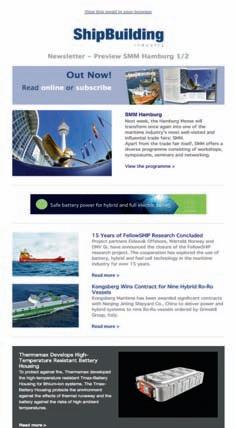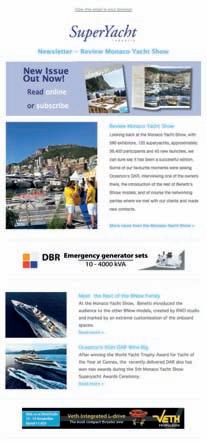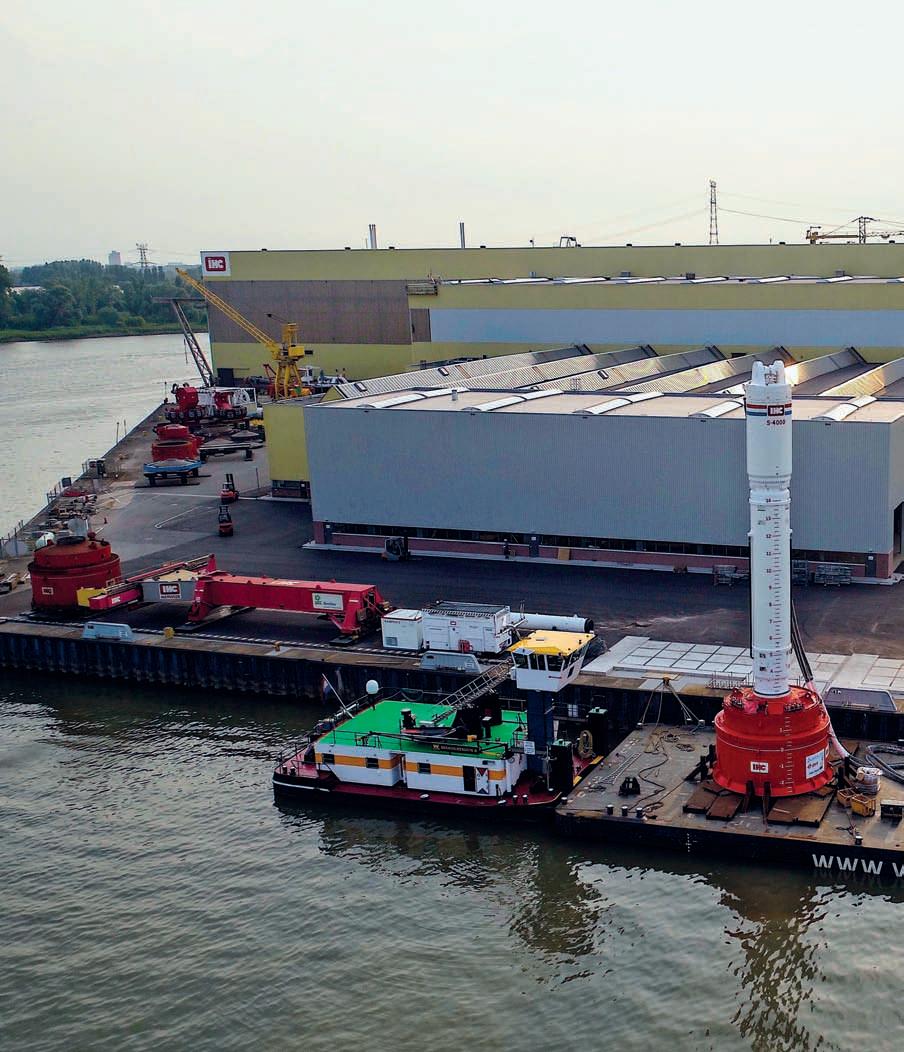
7 minute read
Noise mitigation: in search of the best solution
Monopile-driving at sea is tied to strict rules for the reduction of underwater noise caused froM the driving operation. Many solutions have already been developed to Meet these rules. according to dutch company ihc iQip, one of the challenges lies in finding a technique that efficiently and cost effectively fits all variables influencing pile driving.
All imAges courtesy of ihc iQip.
IHC IQIP is located at a former 23,000m 2 large shipyard in Sliedrecht (the Netherlands).

IHC IQIP is located at a former 23,000m 2 large shipyard in Sliedrecht (the Netherlands), and this literally expresses the company’s roots. Originating from well-known company Royal IHC, with a history of more than 350 years in shipbuilding, IHC IQIP has built up a strong knowledge on vessels and their behaviour. This gave the company a good starting point for the development of a broad range of offshore pile driving and installation tools.
Melting pot “IHC IQIP can be considered a melting pot of practical and theoretical knowledge and expertise, with a main focus on offshore and onshore driving techniques”, comments Henk van Vessem, Product Manager Offshore Renewable Energy at IHC IQIP. When looking at the offshore wind industry, the company has built an impressive track record with the involvement in the installation of more than 4,000 monopiles, 1,200 jacket piles, 45 piles for substations, and 16 met mast piles so far. “Over the years, we have offered our customers a mix of solutions. They have used our Hydrohammers, handling equipment, noise mitigation solutions, templates or a combination of these”, Mr Van Vessem explains. “For us, it is not just a matter of providing pile driving equipment based on our customers’ requests, as we try to look much further than this. We think along with our customers, and advise them throughout the entire project scope. We can then determine the best installation approach in advance, thus reducing risks and costs during the actual foundation, installation, and ultimately, decommissioning.”
Riffgat Noise mitigation rules became effective in 2008 because of the proposed impact the noise of pile driving has on its (subsea) environment. Various noise mitigations solutions have been developed over the years, but according to Michael Schaap, Manager R&D of IHC IQIP, there is no such thing as one best solution that fits everything. “No offshore windfarm and more specifically, no offshore wind turbine is the same”, he tells. “The same applies to the location where the windfarm is installed, as each type of soil, as well as water depth, waves, and currents may require different approaches. In 2012, we were granted the Riffgat offshore windfarm project to supply the noise mitigation system that consisted of the combined use of the NMS-6900 noise mitigation system and a Hydrohammer. Simply said, the NMS consists of a double wall steel screen and >>
a bubble injector system and together with the use of our Hydrohammer system, the contractor could considerably reduce the underwater noise level. The Riffgat project was our first commercial project in which noise mitigation rules applied, and we have learned a lot from this and the projects that followed.”
Low speed, high frequency Throughout the years, IHC IQIP has made numerous improvements. Mr Schaap continuous, “One of our first goals was to try to integrate the various tools of pile driving and noise mitigation into one easyto-use system for lifting, upending, drilling, and noise reduction. This resulted in the Integrated Monopile Installer. Apart from improving hardware, we also investigated the effect of the hammer’s impact. The steel ram weight impacting the steel anvil that rests on the monopile creates a radial expansion of the monopile causing the disturbing underwater noise. This underwater noise is reduced when delivering more, albeit less powerful blows. This has resulted in a concept of pile driving with a high frequency at a low impact. Instead of hammering at a low speed with high force, piles are driven with a higher frequency at a lower force, which causes lower underwater noise levels.
Fatigue damage A further step in the noise mitigation challenge is the Pulse piling system. This system, which is an add-on to standard
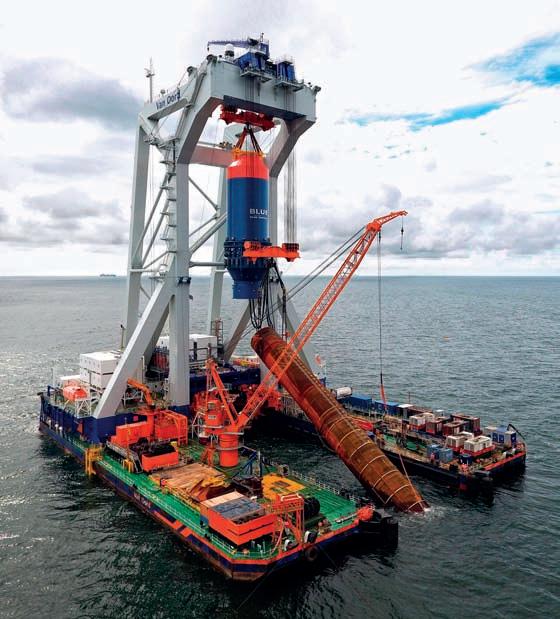
First goal for BLUE Piling is to make the system market-proof.
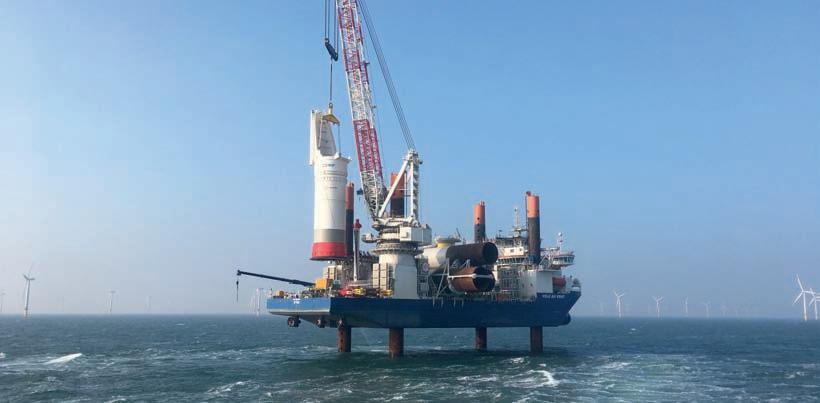
The Integrated Monopile Installer integrates the various tools of pile driving and noise mitigation into one easy-to-use system for lifting, upending, drilling, and noise reduction.
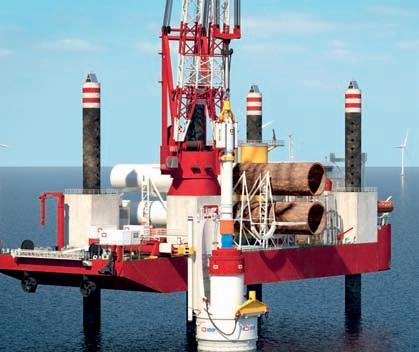
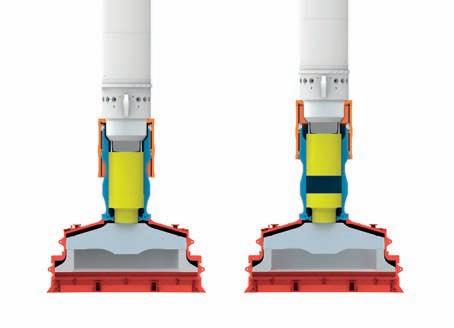
The Pulse system is an add-on to standard hammers, positioned between the piling hammer and sleeve. The Pulse system: the volume in between the plungers can be filled with water, which controls the impact characteristic reducing noise at the source.
hammers, is positioned between the piling hammer and sleeve and dampens the impact and noise with two hydraulic plungers. The volume in between the plungers can be filled with water, which controls the impact characteristic reducing noise at the source. “The Pulse system,” Mr Schaap explains, “can be used in combination with any other noise mitigation system. However, when using it in combination with our Integrated Monopile Installer, no additional noise mitigation measures are needed, which reduces installation costs and increases the efficiency of pile driving operations. The Pulse system also reduces fatigue damage. This makes it possible to further optimise the design of the foundation piles, resulting in additional cost reduction.”
BLUE Piling One of the disadvantages of the Pulse method is that it cannot be scaled beyond certain limits. With monopiles becoming increasingly larger, new solutions are required to allow for an efficient installation. “With the continuing scale-up of the monopiles, “ states Mr Schaap, “more and more force is needed to keep the piling efficient, and larger monopiles also means more underwater noise.” Last year, IHC IQIP took an interest in BLUE Piling Technology, which can be considered as a next step in pile driving. Just like a Pulse hammer, BLUE Piling Technology uses an increased pulse duration to reduce underwater noise levels. BLUE Piling is an innovative piling solution that uses the deceleration of a large water column to deliver a long-lasting blow to the pile.
As a result of the acquisition by IHC IQIP, Jasper Winkes, the developer of BLUE Piling, joined the company. He comments, “BLUE Piling is an innovative piling solution that uses the deceleration of a large water column to deliver a long-lasting blow to the pile. A BLUE hammer has an impact duration of around 200 milliseconds, whereas a conventional Hydrohammer has an impact duration of less than 10 milliseconds, and a Pulse system can reach impact durations up to 30 milliseconds.
Environmentally-friendly According to Mr Winkes, the technology has various advantages over conventional impact hammers. He explains, “The hammer produces very low underwater noise levels compared to conventional hammers. This results in significant cost reductions for the installation of foundations for offshore wind turbines, as no additional noise mitigation solutions are needed. The long blow duration also minimises fatigue during installation, and even the largest piles can be driven with this technology. Being part of IHC IQIP means we now have the means to further improve the system, so we can make the technology ready for commercialisation. Apart from the aforementioned advantages, the technology has more to offer for the future of the offshore wind industry. Mr Winkes states, “The BLUE piling technology also allows for the installation of the completely assembled foundations, instead of installing piles and secondary steel separately. It is clear that this will save a lot of time, labour, and money. It will also further contribute to making the installation of offshore wind turbines more environmentally-friendly.”
Full-scale offshore test The first goal for BLUE Piling is to make the system market-proof. With the current and upcoming tests, IHC IQIP wants to show the market the strengths of the system. When everything goes according to plans, the further improvements will be ready for implementation halfway 2020 and the company is aiming for a full-scale offshore test by the end of 2021. “With our BLUE Piling Technology,” concludes Mr Van Vessem, “IHC IQIP has the most advanced pile driving solution available. It keeps us in the lead and gives us a fine starting point for further growth in the offshore market.”
SUBSCRIBE TO OUR ONLINE NEWSLETTERS


TO REMAIN UP-TO-DATE WITH THE LATEST NEWS IN THE INDUSTRY, INCLUDING COVERAGE ON MAJOR TRADE FAIRS AND EVENTS.
